With an area of 505,990 km2 (195,360 sq mi), Spain is the largest country in Southern Europe, the second largest country in Western Europe and the European Union, and the fourth largest country in the European continent. By population, Spain is the sixth largest in Europe and the fifth in the European Union. Spain’s capital and largest city is Madrid; other major urban areas include Barcelona, Valencia, Seville, Málaga and Bilbao. There are many beautiful and historically significant places in Spain. I describe below nine such places which are not to be missed by the tourist who wants to enjoy his holidays in Spain. These are:
1. The Alhambra and Generalife Gardens, Granada
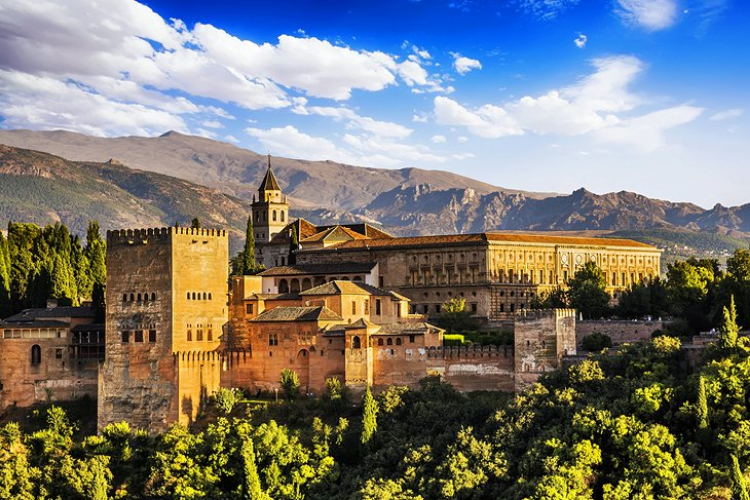
The Alhambra and Generalife Gardens, Granada
No matter how much you have read or how many pictures you have seen of Granada’s Alhambra palaces, this Moorish pleasure palace will still take your breath away. The Nasrid dynasty’s royal palace is the artistic highlight of Spain’s Islamic period, when Al-Andalus — as they called Andalucía — represented the epitome of culture and civilization in Europe’s Middle Ages.
The Alhambra complex includes several buildings, towers, walls, gardens, and a mosque, but it’s the indescribably intricate stone carvings, the delicate filigrees, the magnificent tile-lined ceilings, the graceful arches, and serene courtyards of the Nasrid palace that will haunt your dreams.
That said, the adjoining palace built for the Emperor Charles V, even in its unfinished state is the finest example of High Renaissance architecture in Spain. And Generalife’s terraced gardens offer a peaceful respite from the grandeur, and splendid views back at the rest of the Alhambra.
2. Barcelona’s Sagrada Familia and Gaudi Sites
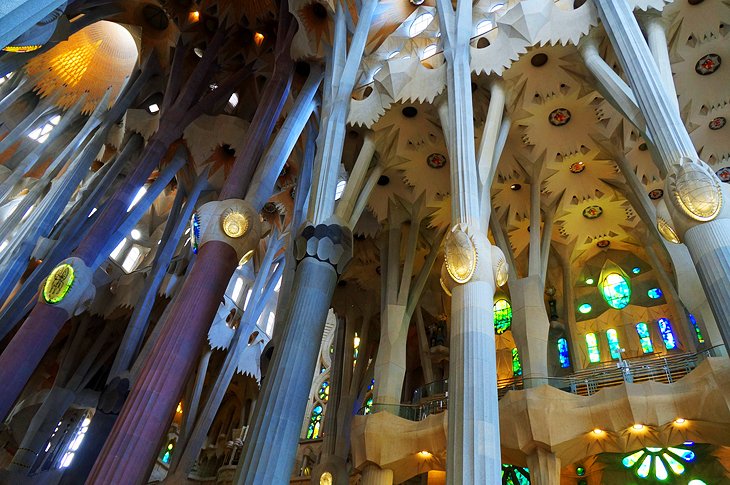
Barcelona’s Sagrada Familia and Gaudi Sites | Leandro Neumann Ciuffo / photo modified
Antoni Gaudi took the architectural style known as Art Nouveau a step further, even, some have argued, into absurdity. The fanciful and outrageous buildings he created in Barcelona have become landmarks, the signature attractions of this Catalan city. Foremost is The Sagrada Família church, officially the Temple Expiatori de la Sagrada Família or the Holy Family Church of the Atonement. One of Europe’s most unconventional churches, it is also unfinished, so as you look down from its tower, you can see the work in progress below.
You may search in vain for absolute straight lines in Gaudi’s Casa Milà, his last and most famous secular work; it resembles a piece of sculpture more than a functional building. Be sure to ascend to its roof — the chimneys are said to have inspired the image of Darth Vader from Star Wars.
Parc Güell overlooks the city from a hillside, the views and gardens framed by fantastical creatures — salamanders, fish, an octopus — and designs in bright ceramic-chard mosaics. A fanciful towered house near the entrance is largely covered in colored ceramics. Unlike most buildings, Gaudi’s appeal even to children and to adults who don’t care a thing about architecture, for one simple reason — they are just plain fun to look at.
Accommodation: Where to Stay in Barcelona: Best Areas & Hotels
- Read More:
3. The Prado and Paseo del Artes, Madrid
4. San Lorenzo de El Escorial
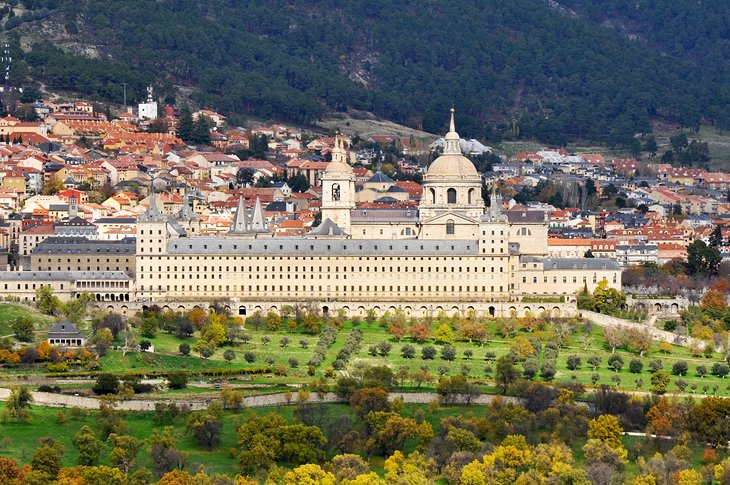
San Lorenzo de El Escorial
San Lorenzo de El Escorial, about 45 kilometers northwest of Madrid, was the summer home of Spain’s kings, and in 1563, work was begun here on a huge complex, which would include a monastery, church, royal palace, mausoleum, library, and museum, all conceived as a monument to Philip II and his reign. The result is a staggering collection of attractions, built around 16 courtyards, its rooms and structures connected by 16 kilometers of corridors. At its core is the church, the highlight of which is Herrera’s 30-meter-high retablo, made of jasper and red marble and approached by a flight of 17 steps.
Along with the vaulted and frescoed ceilings by Tibaldi in the rooms off the lower cloister, highlights of the monastery are the Panteón de los Reyes (the Baroque burial vault of the Spanish kings) and the library, a grand room also decorated by Tibaldi frescoes.
In the palace, be sure to see the Bourbon Suite, where the state apartments of Charles IV are decorated with rare furnishings and 338 tapestries. Beyond are the art-filled private apartments of Philip II. The Picture Gallery below has a large collection of fine paintings, including works by Hieronymus Bosch, Albrecht Dürer, Titian, Tintoretto, Veronese, Velázquez, and El Greco.
5. Guggenheim Museum, Bilbao
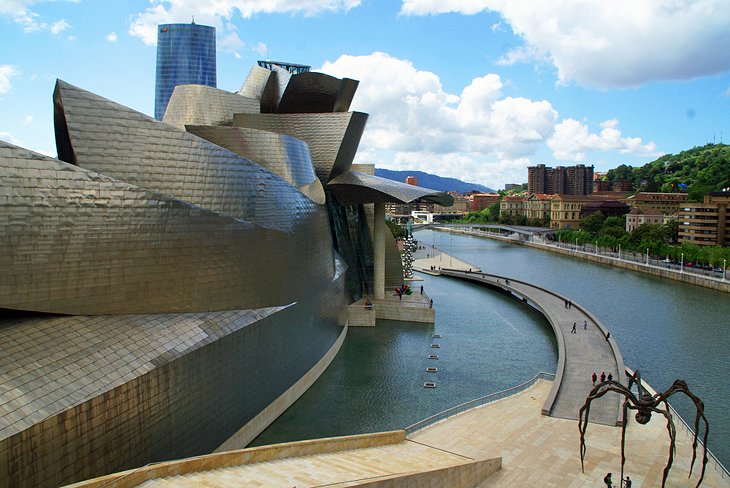
Guggenheim Museum, Bilbao
You really have to see this building to believe it — no photograph has ever done justice to this symphony of shapes, so alive that they seem ready to take wing. American architect Frank Gehry used blocks of limestone and undulating sheets of titanium to turn the notion of modern architecture on its ear. So thoroughly did he succeed that two new terms were born from it: “The Bilbao Effect” — the ability of a city to turn its fortunes around by constructing a single world-class building — and “architourism,” a whole segment of the travel industry revolving around landmarks of contemporary architecture. Inside the museum are traveling exhibitions and rotating displays of its own collections of modern art.
6. Santiago de Compostela Cathedral
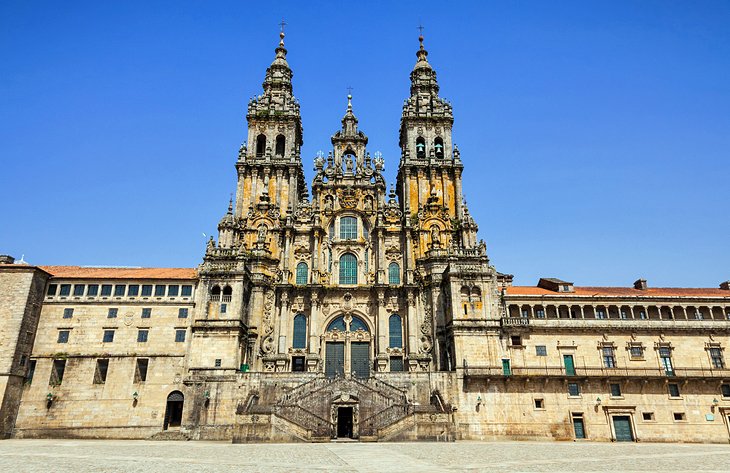
Santiago de Compostela Cathedral
The magnificent cathedral of Santiago (St. James) was built to house and honor the relics of the saint, and it has been the goal of pilgrims since the Middle Ages, the culmination of their completing the famed Camino de Santiago. One of the outstanding monuments of Early Romanesque architecture, the cathedral was built between 1060 and 1211, and despite the Baroque transformation of the exterior in the 16th to 18th centuries, the interior is still in the purest Early Romanesque style.
You’ll see both of these periods at play as you enter the west front, through one of Spain’s most impressive church facades. Step inside to face the Pórtico de la Gloria, part of the old west front now concealed by the 18th-century facade. This triple doorway is one of the largest and most magnificent collections of Romanesque sculpture in the world.
The focal point of the interior is the elaborately decorated Capilla Mayor, built over the Apostle’s tomb. In the center of the high altar of jasper, alabaster, and silver is a 13th-century wooden figure of the Apostle, richly adorned in precious metals and gems. On either side, narrow staircases lead up behind the figure so that pilgrims can kiss the Apostle’s cloak – culminating their pilgrimage. In a crypt under the altar, the Apostle’s remains are in a silver casket.
7. Ciudad de las Artes y las Ciencias, Valencia

Ciudad de las Artes y las Ciencias, Valencia
When Valencia diverted the course of the river that had repeatedly flooded the city, it was left with a broad, flat riverbed spanned by bridges. It was upon this clean palette that the brilliant Spanish architect Santiago Calatrava created a breathtaking ensemble of structures that have become a magnet for aficionados of contemporary architecture. Not only the buildings, but the museums, arts venues, and aquarium (by Félix Candela and the only building not designed by Calatrava) form a series of tourist attractions that rank among Spain’s most popular. Europe’s largest oceanographic aquarium, L’Oceanogràfic, was built in the shape of a water lily with buildings dedicated to different aquatic environments from the tropics to the poles.
8. Costa del Sol Beaches
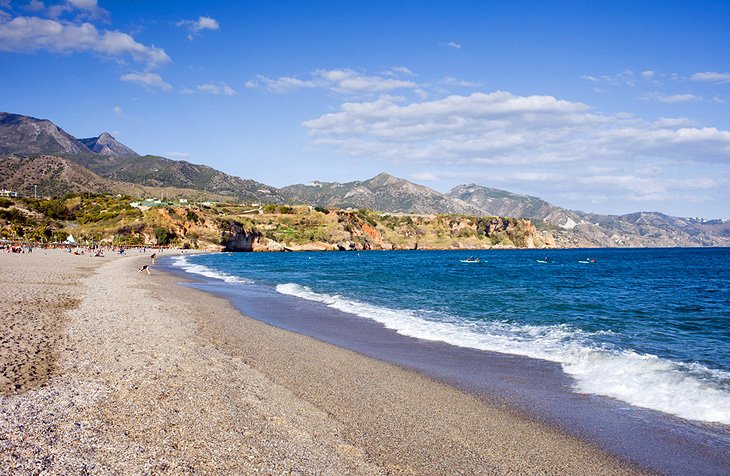
Costa del Sol Beaches
With the record as Europe’s sunniest place, and mile after mile of white sands lapped by gentle seas, it’s no wonder that the Costa del Sol beaches are the goal of sun-starved northern Europeans looking for sun-and-sand getaways. This popularity caused serious over-development initially, but the Andalucian government has not only put a stop to this, it has begun the process of tearing down the worst offenders and returning entire sections of coast to natural landscapes, clean beaches, and attractive new buildings that are more in harmony with their surroundings.
The beaches are not Costa del Sol’s only attraction for tourists. Revitalizing its hub city of Málaga has made this coast even more alluring to everyone. Yachtsmen love the smart marina of Puerto Banus, and avid golfers head west from Marbella’s old-world charms to Nueva Andalucia, known as Golf Valley for its more than 50 courses. A few steps from the beach in Marbella is the old town of whitewashed houses and well-preserved remains of the Moorish Castillo.
9. La Rambla, Barcelona
La Rambla, Barcelona
Strolling along La Rambla on a summer evening, you might think that every single one of Barcelona’s inhabitants was there with you. It’s definitely the place to be after work on a summer evening or on a weekend. This tree-lined boulevard cuts a green line — not a very straight one — through the city center, stretching northwest from the Columbus Memorial near the port.
The section to the Plaça de Catalunya is lined with plane trees, its wide pedestrian zone flanked by a narrow road on each side. Along with its flower and bird markets, La Rambla has a number of book and newspaper stands, as well as restaurants and cafes with open-air tables. Pavement artists, street musicians, living statues, and impromptu performers all add to its lively atmosphere.